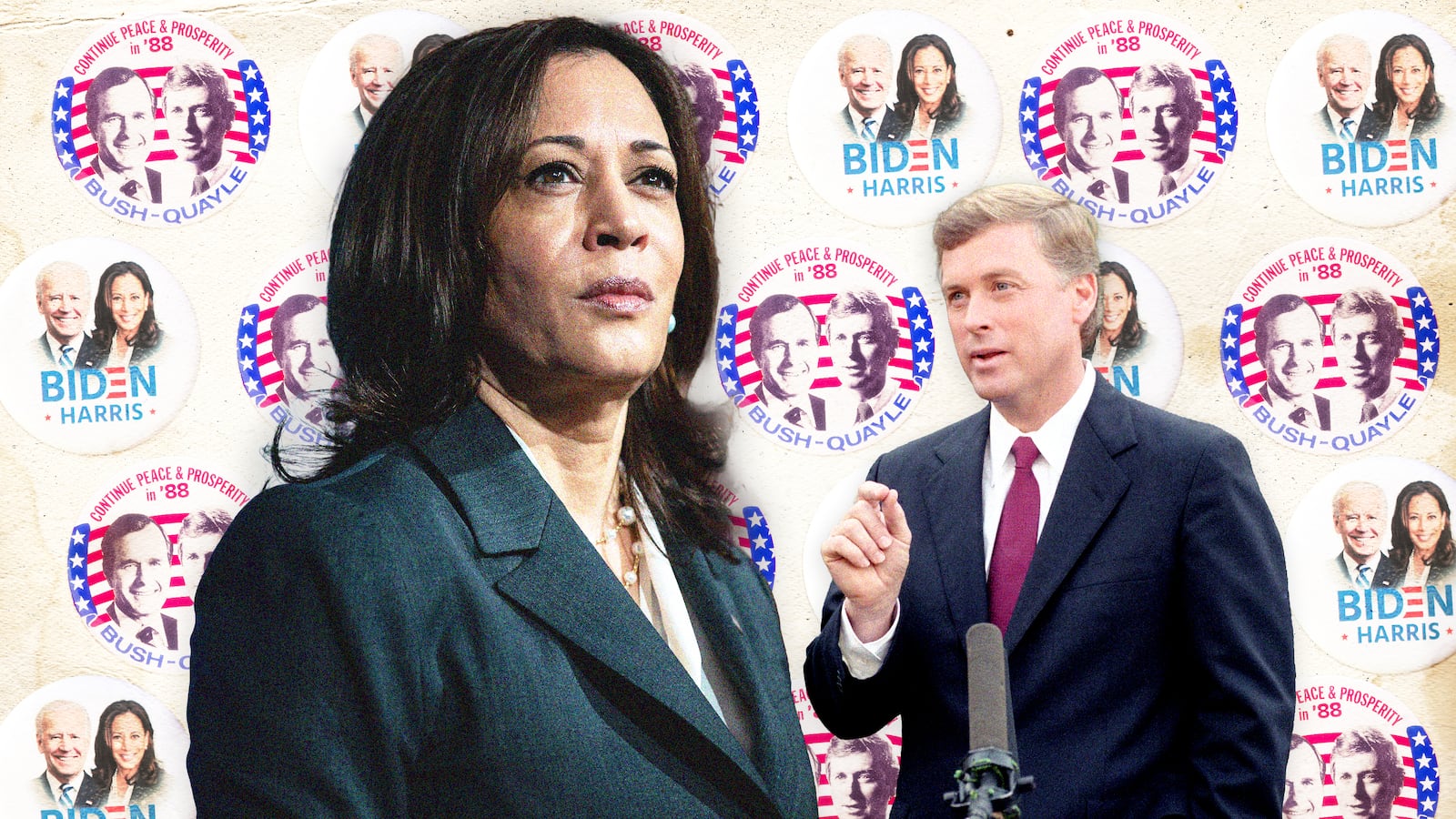This Thanksgiving, the knives are out for Kamala Harris. This week, she became the first woman to serve as acting president, when power briefly transferred to her while Joe Biden was under anesthesia. Nevertheless, rumors are swirling that Biden won’t seek re-election (he and his team vehemently insist he will), and there’s growing concern that Harris—who has had more than her fair share of gaffes and missteps—lacks the political instincts to lead Democrats into the promised land.
Biden’s selection of Harris to be his running mate in 2020 made some political sense. She helped unite the party and balance the ticket. Indeed, they won. But in late 2021, Biden’s needs have shifted. The Virginia gubernatorial election, coupled with subsequent polling, suggests that many suburbanites are turning against a Democratic Party they perceive to be too progressive. At the same time, Biden faces serious challenges, including rising inflation, a border crisis, supply chain troubles, violent crime rates, and more.
The things he has tried to get help from Harris on, starting with immigration, have not panned out. In general, Harris’s performance has only contributed to the sense that this is an administration that isn’t quite ready for primetime. If Harris is the bridge to the future, that bridge isn’t holding its weight.
But is the criticism fair? During a recent discussion for Bloggingheads.TV, my friend Bill Scher, a liberal columnist for Washington Monthly and Real Clear Politics, reminded me that being vice president is a tough gig. As John Nance Garner famously quipped, the job isn’t worth a “warm bucket of spit.” You don’t want to overshadow the president, and you can’t really differ with him, so it’s almost, by definition impossible to look like a strong leader. You go to funerals. You get handed thankless projects. This is why, although veeps often ascend to the presidency (think LBJ or Gerald Ford), they generally aren’t elected to immediately succeed their boss.
The most recent exception was George H.W. Bush, who basically just won Ronald Reagan’s third term. But is he a helpful model? Sitting at a less than 40 percent approval rating (and Harris’s is lower than that), Biden doesn’t look to be in the same league as the Gipper. But if somehow things turn around the way they did for Reagan after coming through a recession and having a rough midterm election in 1982, Harris might be in a good position to try and replicate Bush’s feat in 2028.
But even in the highly unlikely event history were to repeat itself, it’s worth noting that Bush still had to fight for the Republican nomination in a fairly crowded 1988 primary, still had to overcome the “wimp” factor the media labeled him with, and still had to run an aggressively negative campaign against a less-than-charismatic Democratic opponent, all in order to defy history.
But that’s not Harris’s only challenge. Scher points out that there are basically two models for veeps. The first is an old D.C. hand who provides “insider” cred and experience to the ticket. The second is the inverse situation, where the president is the insider and the running mate balances the ticket by virtue of some other qualities, such as age, identity, or charisma.
In recent history, the former model has been much more common. Walter Mondale, Al Gore, George H.W. Bush, Dick Cheney, Biden himself, and Mike Pence all had more D.C. experience than their respective principals.
This model also seems to be the better model, in terms of boosting the image of the vice president. In this scenario, the veep generally has built up lots of friends and contacts in the media and the bureaucracy. When the president slips up, other elites can fantasize about how much more competent and sane things would be if (fill in the blank) was running the show.
The most recent example of the Harris model was Dan Quayle. Now, in 2021, we can look at Quayle as the man who saved democracy by telling Mike Pence he didn’t have the power to refuse to certify Joe Biden’s electors. But for most of my life, Quayle has (unfairly, in my opinion) been a political punchline.
Quayle had been a rising star in the U.S. Senate prior to becoming Bush’s running mate. Even when Quayle sought the Republican nomination in his own right in 2000, his old boss’s formerly deadbeat son, “Dubya,” swooped in and took away the only card he really had to play: the notion that he was the next in line and rightfully 41’s heir apparent.
Since modern history offers a small sample size for this model of vice president, the other (similar) recent example is John McCain’s selection of Sarah Palin. McCain, like Biden, had a ton of insider experience. What he needed was some youth and energy—and conservative cred to keep the base happy. So he picked Palin.
The point to all of this, of course, is that Kamala Harris is (a) in a job that is inherently thankless, and (b) represents a model of vice presidents that has historically not worked out well for the person occupying the position.
The deck is stacked against her. Further complicating things is the fact that her boss is seen as old and possibly on his way out the door, meaning the expectations for her to mature are high while the learning curve is steep.
While this might help you sympathize with her plight, it does not mean that Harris was a good pick—or that she is suited to inherit the mantle of leadership. Biden boxed himself in by promising to select a woman, which eliminated something like half of his options from the start. Harris has not had a long and distinguished career in the U.S. Senate, and her 2020 presidential campaign was lackluster.
Harris’s main problem strikes me as being mostly indescribable. It’s almost impossible to define why she turns so many people off. Yogi Berra, that great baseball philosopher, once had a line about how “If people don’t want to come out to the ballpark, nobody’s gonna stop ’em.” That may be the best way to sum up Harris’s fundamental problem. No matter how hard they try to package the Kamala product, people—including Democratic voters in the 2020 primary—just haven’t been buying what she’s selling.
Yes, I’m sure there are some racists and sexists who oppose her for those reasons. Generally, though, to the degree her identity harms her, it’s because people have high hopes for her to be a transformational leader. There is a lot of pressure on Harris to be this amazing historical figure, and that’s a lot to live up to.
In today’s media environment, it helps for a president to be a true political athlete, and it just may be that Harris—despite having been given so many opportunities to shine—just doesn’t have it.
This reminds me of the NFL, where having an “elite” franchise quarterback seems to be key to winning, and yet, the track record for identifying which college QBs will rise to the occasion seems to be mixed, at best. Harris is like one of these players. She showed flashes of brilliance on occasion, and there was a hope that with some time on the sidelines holding a clipboard, coupled with lots of practice and reps, she could mature into the future. For now, though, she’s starting to look like a bust. And some of the fans are already looking around for a better draft pick.
Maybe they’ll be proven wrong. As I’ve just described, there are a lot of obstacles in her way. These obstacles could be obscuring our vision. But I wouldn’t bet on it. If Kamala Harris is the last, best hope for the Democrats, the last obstacle standing between us and another Trump presidency—and she may be—then God help us.


